-

The facade of the home shows the narrow lot width with the typical side porch feature.
-

Guests for the home tour are greeted by Sophia as the check-in point on the porch of the O'Donovan house.
-

The house was designed by local architect, Michelle NacNeal who also planned the Aragon community. The landscaper is Mike Robertson. Ms. Ritchie served as her own interior designer and the home is a reflection of her career in public service.
-

In a Charleston Side Yard home, pediments and korbels are important decorative elements. The pediments are the decorative elements on top of the colums. Korbels are the corner fan-like decorations in open lattice work.
-

-

-

The rear storage building can be seen through the kitchen window.
-

-
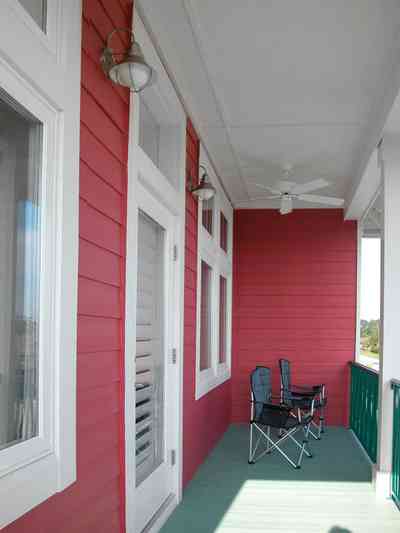
Pensacola Bay can be seen from the second floor balcony.
-

-

-
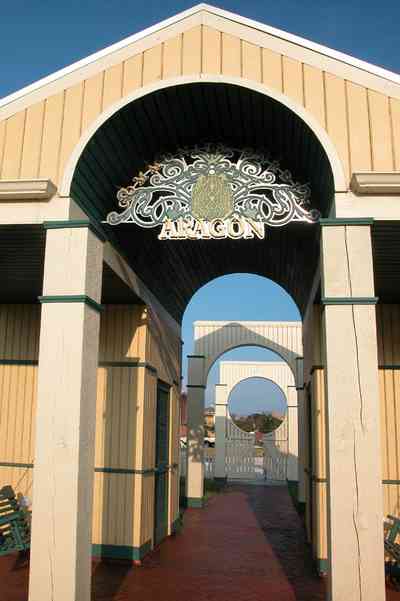
-

-

-

The crew and ad agency representatives watch the actors during one of the first takes of the day.
-

Porches surround the house on both floors.
-

This side view of the house shows another interesting turret on the back.
-

The distinguishing feature of a Neoclassical house is a portico of white classical columns, Ionic, Corinthian or Doric columns, dormer windows, and side porches are elements common to the style of the 1900's to 1940's.
-

This house is built in the classical revival style.
-

The massive front pediment is flanked by clusters of columns.
-

This home is another example of classical revival style. The curved central portico gives the house a soaring grace.
-

The blooming azalea's form a lace trim in the garden.
-

This is a typical Cracker homestead. Cracker refers to the unpretentious people and architecture found on farms and in rural communities still sprinkled throughout the Florida peninsula and panhandle wetlands.
-

A separate kitchen structure was built out back to isolate the heat of cooking and the hazards of fire.
-

Water was pumped by hand. The well was dug at the rear of the house adjacent to the kitchen.
-

The pump is set just off the back of the main house.
-

With broad porches and this "dog trot" breezeway, the interior space was somewhat insulated for direct sunlight. It also served as a sheltered workspace. The kitchen building is at the end of the walkway.
-

Houses were built high up off the damp ground on piers.
-

The outhouse can be seen through the trees. Toilets were small wooden buildings commonly with two seating spaces. Unheated, the privy was cold in the wintertime. Waste built up under the seat until it was necessary to move the privy, or construct a new one. At night, women and girls made use of a flanged bucket known asa a slop jar and kept it under their beds. There is a slop jar on the corner of the porch. Indoor plumbing did not come to most farms until the 1930's, 1940's, or 1950's.
-

Cracker homesteaders oriented their houses on a north-south axis which maximized solar impact on all three sunny sides. Such a tactic helped to keep the wall dry. Placement of the fireplace and chimney in the north gable end would keep that fourth sunless wall dry as well. In the photograph, the wood is stacked off the ground alongside of the chimney.
-
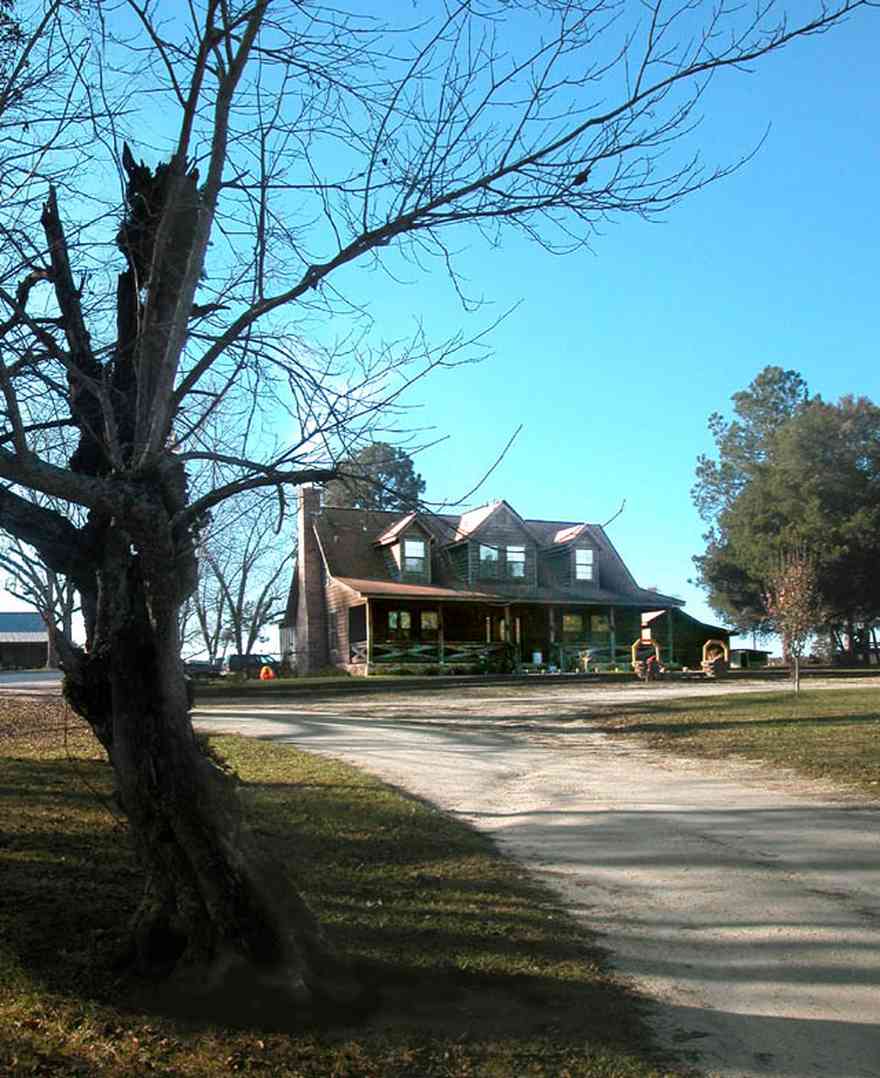
The home is centrally placed on a hill.
-

The house is located in the historic district.
-
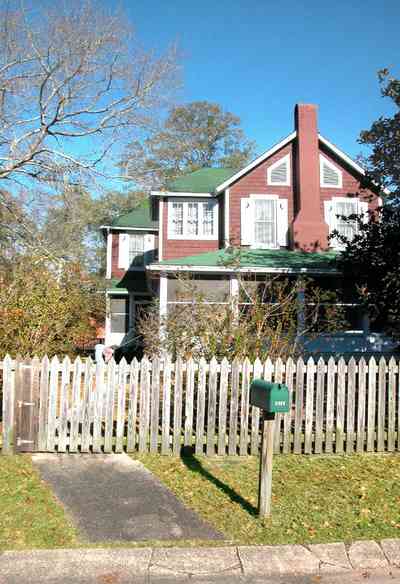
The side of the home is accessed from Church Street.
-

The house is surrounded by groves of hardwood trees.
-

The home is a modern interpretation of the Jacobean style, based on medieval English houses.
-

The home is located on a large lot overlooking Bayou Texar. The lot is bisected by Whaley Avenue. A summer kitchen and boat dock are on the water side of the street.
-

The front is divided into three porch types - screen, open and glass enclosure.
-
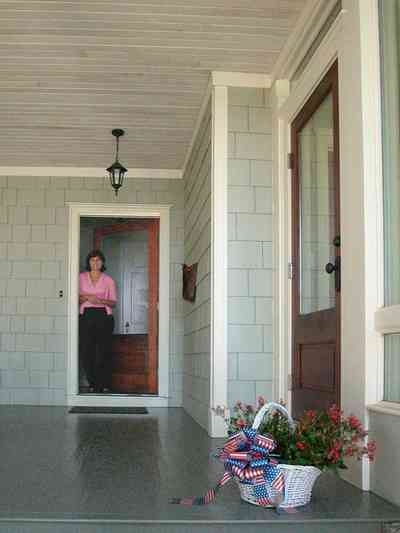
Tricia Mangrum stands at the front door. The door on the right is for the office.
-
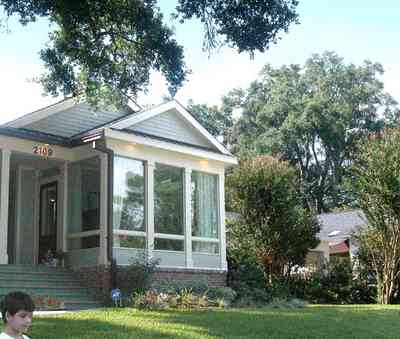
There is a glassed-in room used as an office in the front of the north wing of the house which matches the screen porch on the south wing.
-

The glassed-in front porch is used as an office by Michael Mangrum.
-
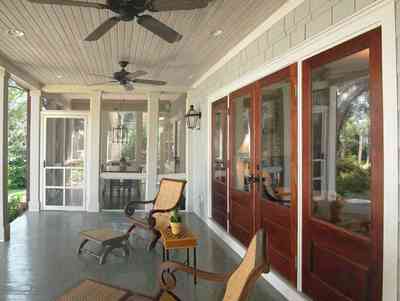
An open seating area is located between the screen porch and the glassed-in office.
-

The tree swing is a family favorite.
-

A screen porch is on the south wing of the home.
-

-

The screen porch enclosure is on the south side of the house.
-

The screen porch functions as a dining area.
-

Bayou Texar can be seen from the screen porch.
-

The living room adjoins the open front porch.
-
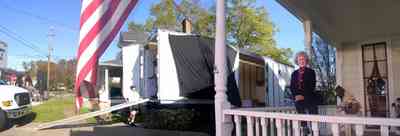
-

-

-

-

-

-

The French doors lead to the screen porch.
-

The screen porch serves as an outdoor living area.
-

The screen porch serves as an outdoor living area.
-

The second floor sceen porch and the open porch are auxillary living spaces.
-

-

-

-

-

The hipped roof is a distinguishing feature of the bungalow style which is particularly appropriate for hot climates, since warm air rises up into the high roof and leaves the rooms below cooler.
-

The original concrete porch flooring was replaced with pine wood by Ron Berthelot.
-

One or one-and-a-half-story Craftsman houses are called bungalows. The Berthelot bungalow exemplifies the style with its wide, deep front porch, supported by thick, simple columns which sit on brick pedestals.
-

The Craftsman (or Arts and Crafts) movement in America developed as a reaction against the machine-made ornamental excess of the Victorian era. This was a back-to-nature movement, reflecting a desire to return to simpler times when craftsmen worked with their hands and took pride in detail. Structural detail and the use of good materials were prized over applied ornamentation. The bungalow has its roots in California, where this style was well suited to the warm climate. It then spread across the country to become one of the most common middle-class designs from 1910 to the 1930's.
-

New glass-front kitchen cabinets were designed for easy access from both kitchen and dining areas. This feature benefits the homeowners every day.
-

Visible outside the sunny dining area are deep rafters, which are typical of bungalows, craftsman architecture, and southern seaside cottages, all suggested by this renovated and restored 1928 home. To maximize views, shutters are the only dressing on any windows. These were salvaged from a garage sale. The 1950's turquoise and black dinette was grabbed at a flea market in Pace, Florida, just north of Pensacola.
-
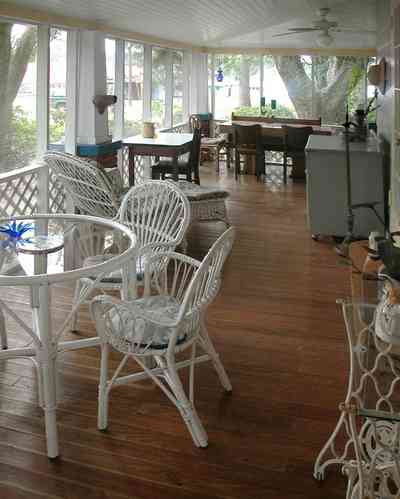
Much of the year, the bungalow spreads out-of-doors. At the Berthelot home, four French doors open into the screened porch, which is comfortably furnished for relaxing, eating, and entertaining. In this Northwest Florida climate, the cooler autumn and gloriously floral spring are especially welcoming, but the shady setting, southern architecture, and a ceiling fam lure folks out even on hot summer days and nights.
-
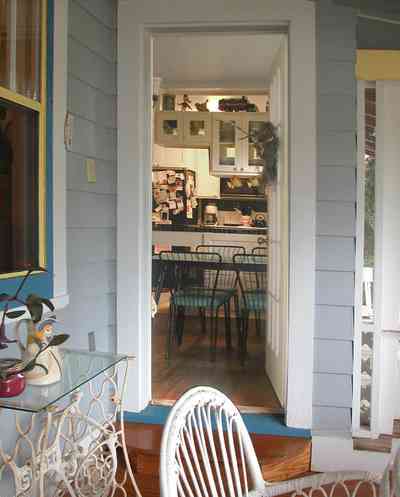
By lowering the pine porch floor and adding a step down, Ron enhanced spaciousness. The original beveled ceiling is echoed in new kitchen cabinets. Open space atop the cabinets is ideal to display serving pieces or fun collectibles, such as an antique Donald Duck, a tin top, and a handmade wooden bus.
-

Wire-mesh screen was used on windows and doors in the Victorian era, but it was the Craftsman bungalow style that introduced the screen porch to the American home. Screen porches served to blur the distinction between outside and interior space and allowed the benefits of fresh air to be enjoyed without the annoyance of insects.
-

The screen porch provides a large exterior living area on the south and west side of the Berthelot bungalow.
-

The half acre, 150 x 125 foot lot still benefits from the masterful gardening of the Larcom family who owned the home for decades. The Berthelots are particularly indebted to camellia expert Franklin B. Larcom whose legacy blooms faithfully each winter and spring.
-
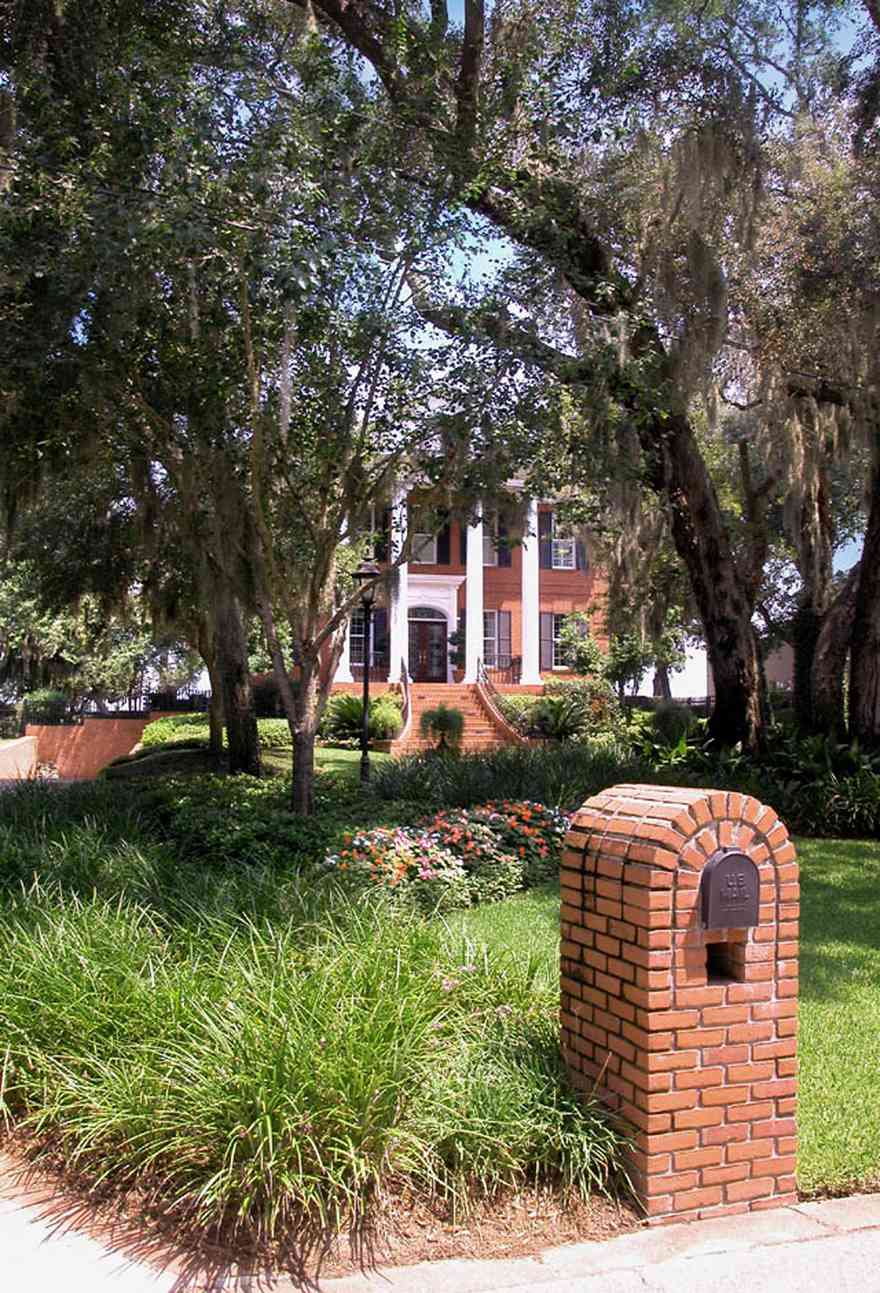
-

-
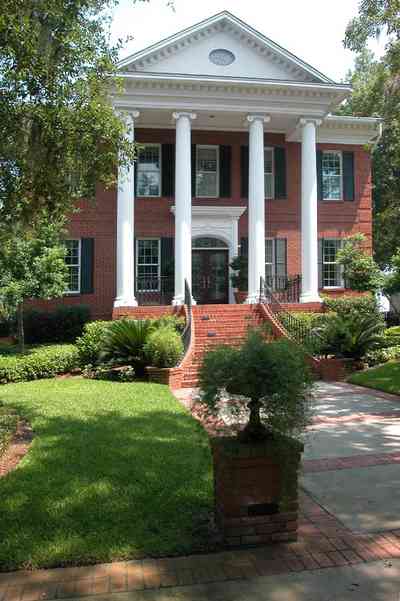
-

-

This is a view of the home across the street from the driveway.
-

-
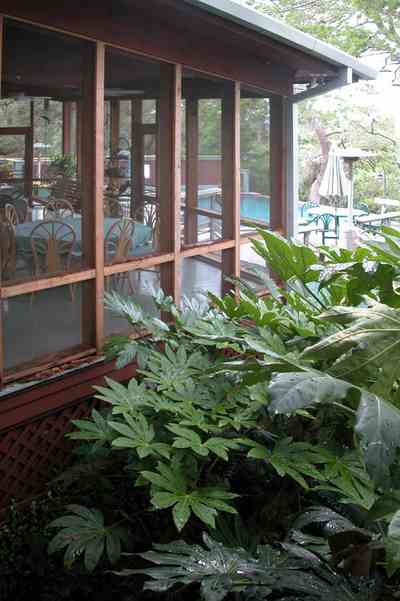
-
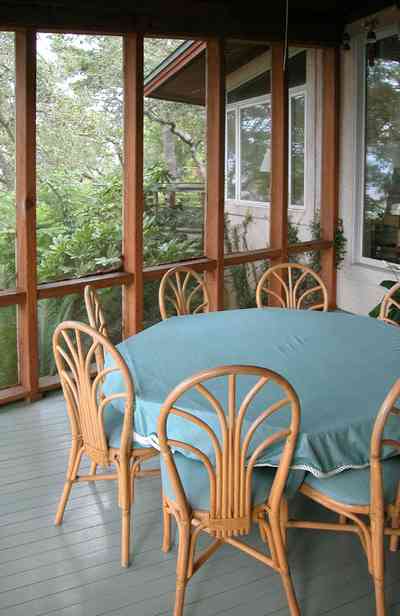
-

-

-

-

The great room has a view overlooking Escambia Bay facing north.
-

The back porch view shows the shallow width of Dead Man's Island. The bay side of the island has narrow dune formations. Sea grasses and trees are the vegetation on the channel side of the island.
-

A typical small bunkhouse has a screened in backporch.
-

The Old Schoolhouse Inn offers luxury accomodations.
-

The rooms at the School House have high ceilings and hardwood floors. Each room has a full bath, microwave, coffeepot and mini refrigerator.
-

The cottage has a back porch that overlooks Wolfe Creek.
-

The restaurant is open on weekend evenings for dinner and available for special events.
-

The restaurant is two blocks from the courthouse.
-

There are two front rooms which serve as dining areas.
-

The dining rooms are accessed from a central hall.
-
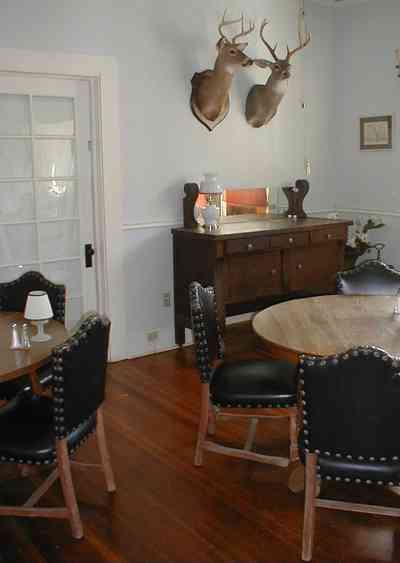
This dining room is on the south side of the central hall.
-

The dining room is furnished like a hunting lodge.
-

The house is situated on 40 acres of pasture land.
-

-

-

-

A series of decks and walkways lead down the hill in the rear of the home.
-

-
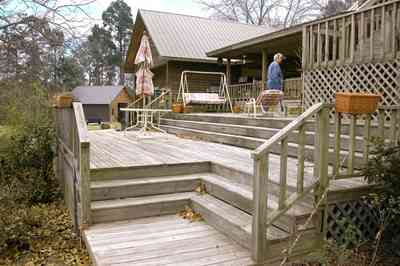
-
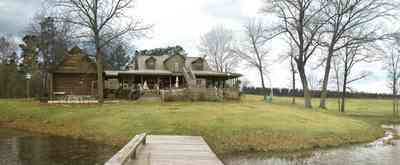
-

-

-

A combination of elements, such as the small pediment forms over the windows and front door echo the large pediment over the front porch.
-

The house is located on the corner of Conecuh and Berryhill Street.
-

The two-story structure is 3,600 square feet with 4 bedrooms and 4 bathrooms, a formal parlor and living room with an additonal family room.
-

This house has the distinction of having the first indoor tub installed in Milton, Florida. That claw-footed model is still in use.
-

The house is an example of gothic revival architecture which its central tower, unique silhouette and decorative elements.
-

This unusual Victorian home was said to have been shipped upriver in several pieces.
-

-

-

From the second level deck, an northeasterly view reveals a shoreline with white crystal beaches. This area is known for sugar sand dune formations that have been called the whitest beaches in the world.
-
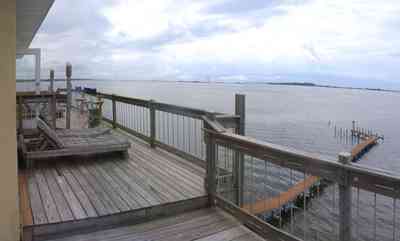
This view from the second level deck faces southeast on Santa Rosa Sound.
-

The owner's dog Ginger, meanders along the dock with the southern facade of the home and beach visible in the background.
-

The front porch is flanked by guardian lions.
-

The windows on the first floor extend from floor to ceiling in an arch design using leaded glass panes. The doors are built in double sets.
-

This is a view from the porch adjacent to the master bedroom overlooking the front yard.
-

The upstairs deck of the Florida Room is a convenient porch off the master bedroom.
-

The windows on the east side are sheltered by canvas awnings.
-

-

-

-

-

-

-

-
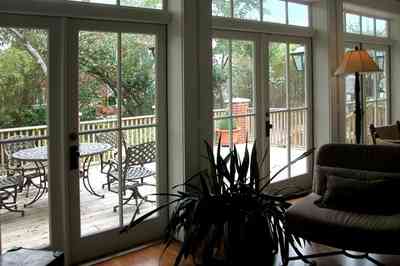
-

-

-

The door in the breakfast nook opens onto the back garden.
-

A small deck connects the screened porch off the family room with the breakfast nook.
-

The screened porch adjoins the family room.
-

-

-

-

The small window is decorated with three styles of columns used on the house facade.
-

The family room opens onto the screened porch.
-

-

Full length window open onto the front porch. The facade of the house faces south.
-
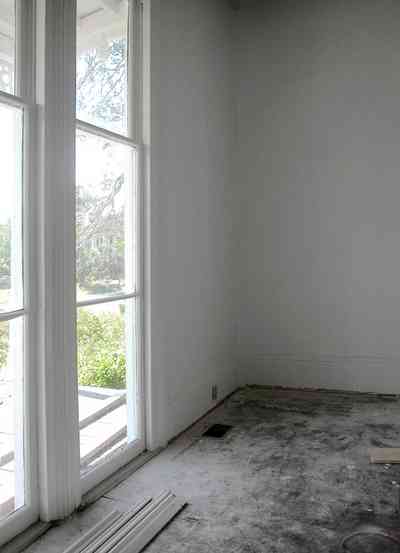
Floor length windows open onto the front porch in the west front parlor.
-
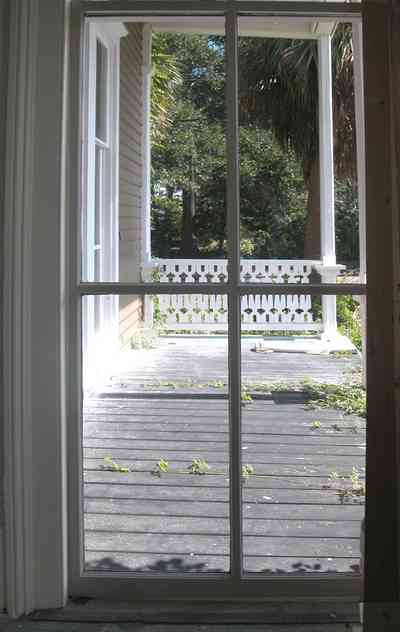
There is a front porch set back on the east side of the facade. This is a view from the central hall.
-

The east parlor has several floor length windows which open onto the front porch.
-

Two full length windows frame the east corner of the house in the front parlor.
-

The design of the home is based on classical or Renaissance precedents.
-
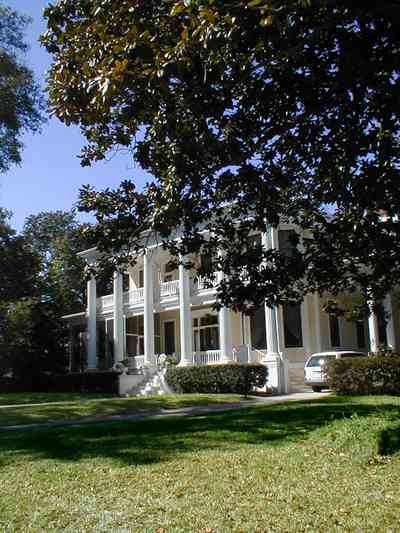
The Greek Revival home on the corner of Brainard and Spring Street was built in 1910.
-

-

-

-

Original materials were procurred to match the new building including cedar shakes from Canada and cypress beams from Louisiana.
-

The screen porch was detailed to match the front porch of the main house and brackets were placed to support the exposed rafter tails as on the main house.
-
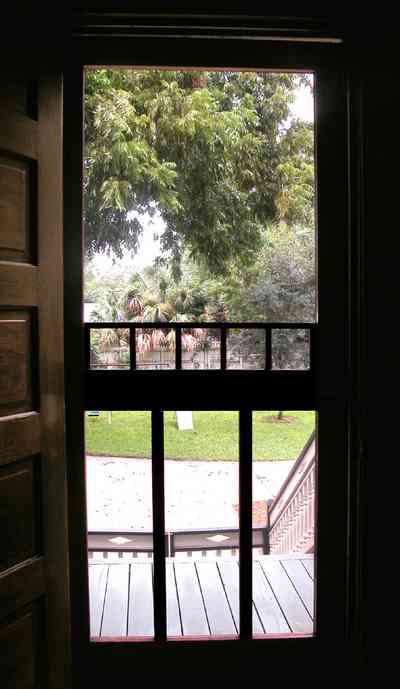
-

This window is on the west side of the front living room.
-

-

-

-

-
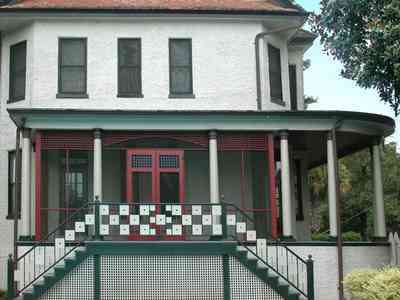
-

-

-
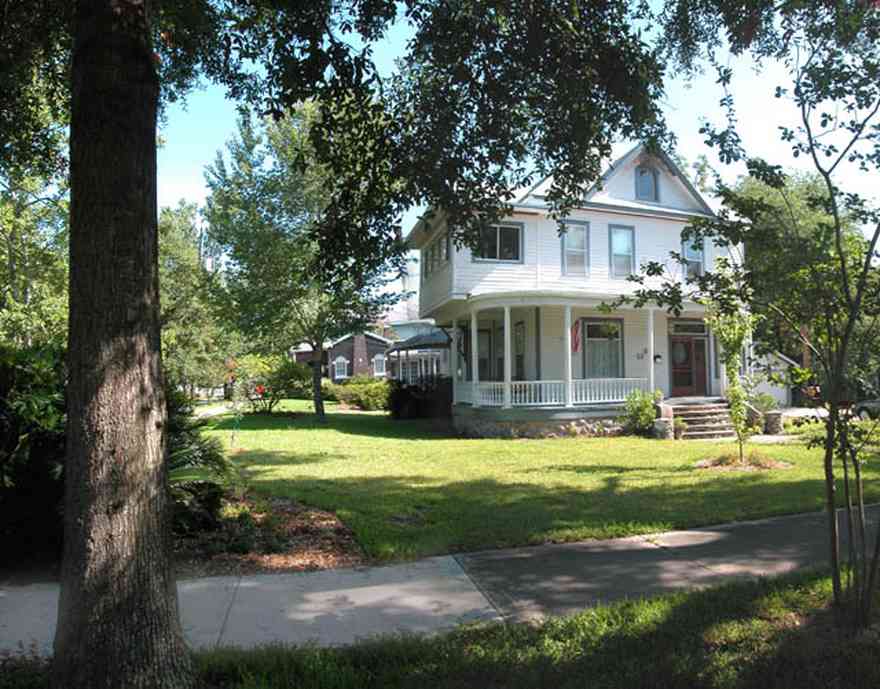
The Queen Anne house has approximately 5000 square feet of living area on three floors. It is located on the northeast corner of Gonzales and Baylen Streets. The property was much larger when the house was built, but an owner during the 1920's sold the backyard to his son because of his desire to have him live close by.
-
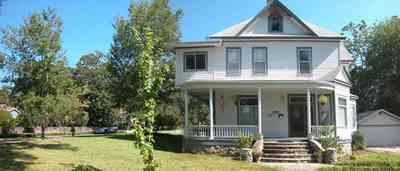
A Florida room was added to the home in 1940 to allow more room for one the quadroplex apartments upstairs. It breaks the Victorian lines of the home but there are no plans to remove the addition.
-

The stone on the exterior of the house were ballast stones thrown ashore by 19th century sailing vessels that were in Pensacola to take on lumber. Stones are commonly used in large North Hill homes.
-

A balcony railing was situated as porch roof trim. Plans are underway to restore this important architectural element.
-
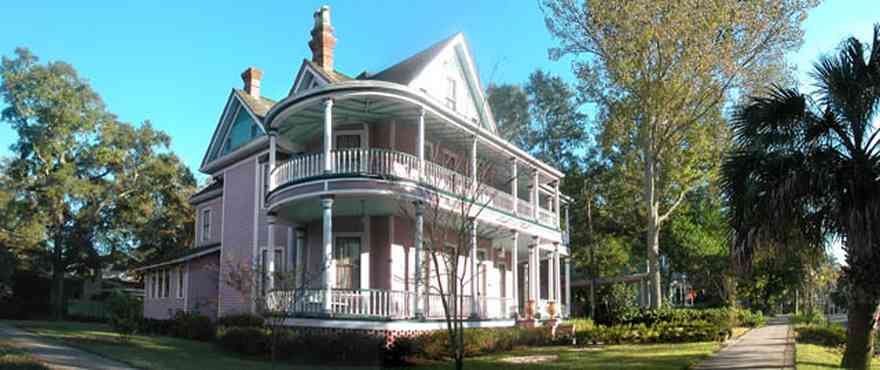
Queen Anne houses are spectacularly crafted.
-

This is the corner of LaRua and Barcelona Street.
-

-

Queen Anne house are characterized by towers or turrets.
-

-

-

Some of the streets in the Old East Hill neighborhood have an uncovered brick base.
-

-

-

-

-

-

-

-

-

-

-

The house was rebuilt in 1995. Stainless steel trim and hardware were added to the exterior finishing.
-

The second floor deck wraps around the house and is an extension of the interior living space.
-

The staircase bisects the deck leading to the downstairs living area.
-
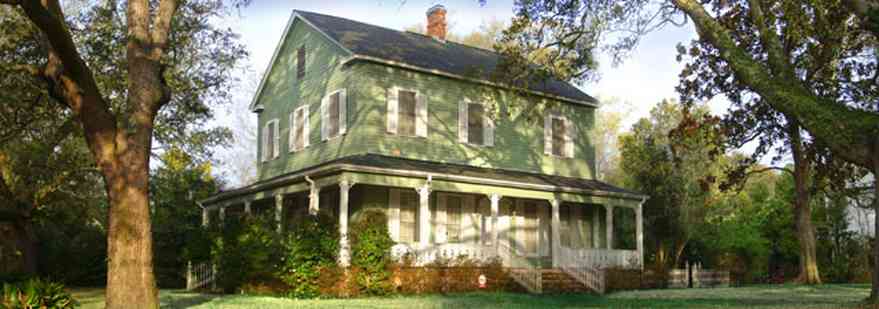
The home is a vernacular farmhouse with one-story porch.
-

The vernacular farmhouse can be seen as an attempt to return to the good old days, with a rocking chair on the front porch.
-
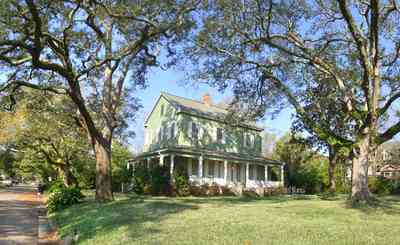
The oak trees create a tunnel effect.
-

Vernacular homes are often identified by their structure, rather than ornament.
-

The back of the cottage faces the LaValle House.
-

This is a north view of the cottage.
-

From the vantage point of the back porch of the cottage, the Lear House can be seen through the trees. The houses are separated by a picket fence.
-
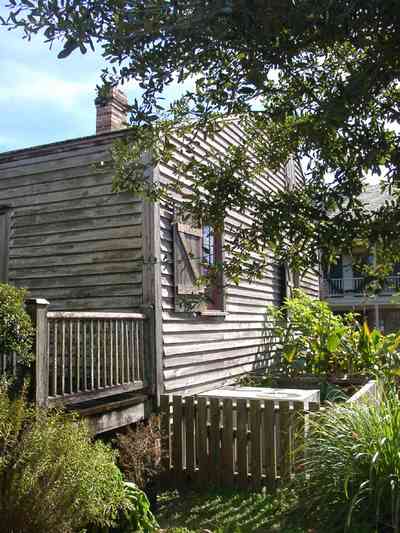
At the northwest corner of the cottage, the facade of the Tivoli House can be seen.
-

From this side view, the kitchen garden can be seen. It is planted and maintained by Escambia County Master Gardeners. A variety of greens and lettuce are the winter crop.
-

In this view three houses in the village complex can be seen. The Julee Cottage is directly behind the LaValle House. The Tivoli House is the last building on the right of the photograph.
-
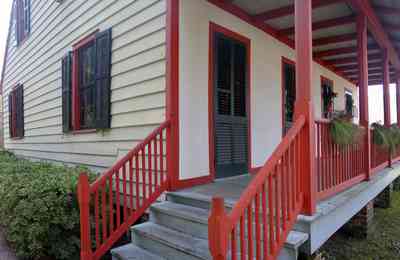
The front porch faces Church Street.
-

The LaValle house museum is a rare example of French Creole colonial architecture. LaValle House was built during Florida’s second Spanish period by Carlos LaValle and Marianna Bonifay. The house is furnished with authentic 18th and 19th century artifacts recreating the frontier lifestyle of Pensacolians.
-

The Lear House is a museum in the Historic Village. The interior is furnished in the style of the 1920's.
-

The Lear House is a central element to the development of Historic Pensacola Village. Since 1988, a series of grant projects have prepared the structure for its role as a museum house. The house museum theme completes a historical timeline in the Historic Pensacola Village that is launched from the exhibits of the Colonial Archaeological Trail. The time period represented at the Lear House provides a contrast to the Victorian theme displayed at the nearby Dorr House.
-

A view from the west side of the first floor front porch. Zaragoza Street can be seen on the right and the interior yard of the home is on the left. The Lavalle Cottage Museum is in the far left corner of the site. There is a common kitchen garden and courtyard between the buildings.
-

From the front porch facing south, the Weaver's Cottage can be seen to the right. The entrance of the parking lot that services the complex is left of the Weaver's Cottage. Twenty-five vehicles can be parking alongside and behind the cottage.
-

The gardens around the house are tended by the Escambia County Master Gardeners. A bed of caladiums wrap around the west side of the house.
-

Colonial re-enactors give tours of the house during the yearly open house at the village.
-

The old Episcopal Parish schoolhouse on Church Street can be seen from the northwest corner of the house.
-

The Marker was placed by Don Tristan de Luna Chapter of the National Society, Daughters of the American Colonists, and Historic Pensacola Preservation Board, 1992. The text of the marker reads as follows: The Lear-Rocheblave House was built on the site of the British Government House of the 1770’s. Built by John and Kate Lear, the house was purchased in 1897 by Benito Rocheblave, a local tug boat captain. The Rocheblave family has long been part of West Florida’s historical tradition, having settled in Colonial Spanish Florida around 1817.
-

The viewer is facing the front doors of the cottage on the porch. A reflection of the Lear House can be seen in the window of the door on the left.
-

The viewer faces west from the vantage point of the porch. The Julee cottage is center frame and the side garden of the Lear House is on the right.
-

The cottage is a Gulf Coast architectural style with two front doors. The house was divided into two one-room apartments. The pyramid roof was once a common sight in Pensacola. The style is wind-resistant during hurricanes and tropical storms.
-

This view of the cottage is taken from the side yard of the Lear-Rocheblave House across the street.
-

The facade of the house faces Zaragoza Street. The original Tivoli High House was demolished in 1937. It was reconstructed in 1976 from photographs and archaelogical evidence. The first floor of the Tivoli House serves as the Historic Pensacola Village gift shop and ticket office.
-

The second floor porch of the Tivoli House forms an arcade over the sidewalk on Zaragoza Street.
-
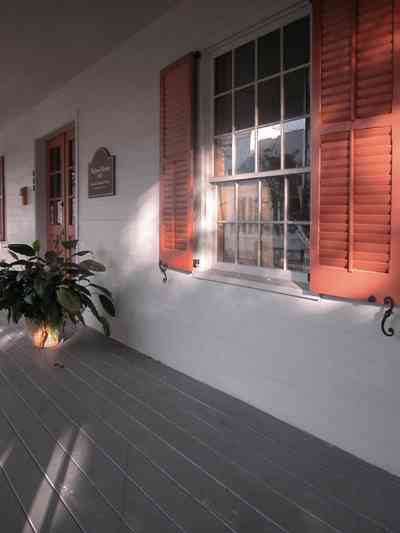
An apron porch with an overhang helps keep the house cool during the hot Gulf Coast summers.
-

Currently, the house has been leased for use as an art gallery, "Expressions".
-
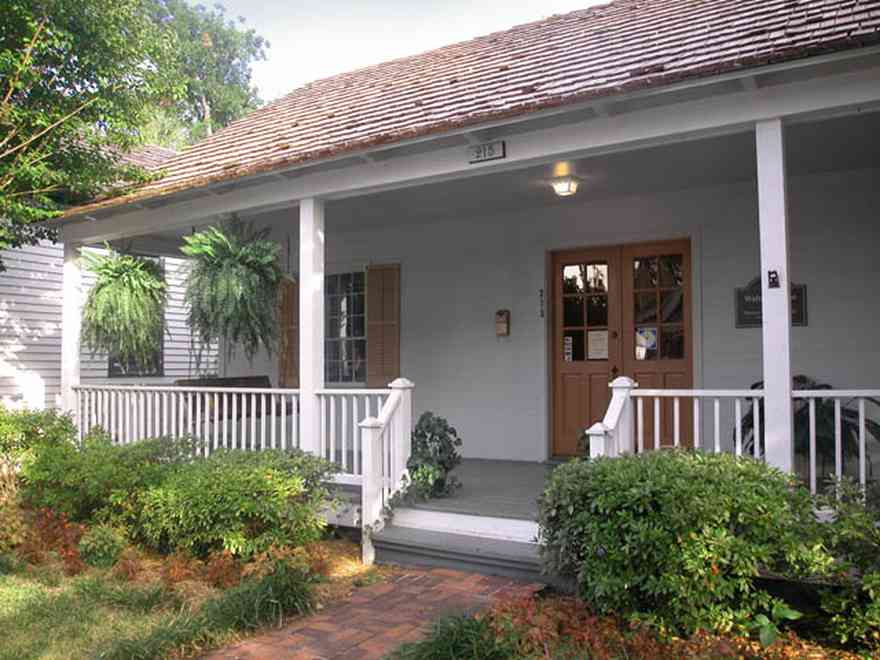
The house is situated on the south side of Zaragoza Street between the Moreno and Weaver Cottages.
-

The house is a good example of a French Creole Cottage. It is rectanglular design with a central hallway and high ceilings.
-

second floor porch trellis
-

south view from second floor porch
-

second floor porch - south view
-

Ceilings of the front porch were traditionally painted blue.
In the South Carolina Low Country, there's a name for the blue of porch ceiling: haint blue. Alphonso Brown, a guide with Gullah Tours in Charleston, S.C., explains that a haint is a spirit or a ghost, and in Charleston, many people also paint the trim on their houses blue to ward off evil spirits.
-

-

-

-
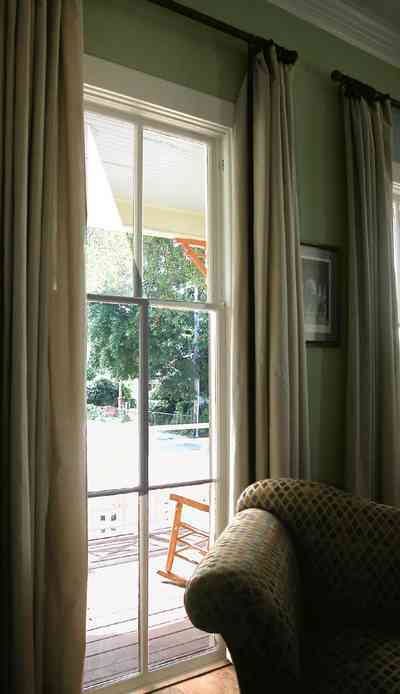
-

-

-

-

-

-

-

The building complex consists of four dwelling units. The two front units are designed for combination office and residential use.
-

-

-

-

-

-

-
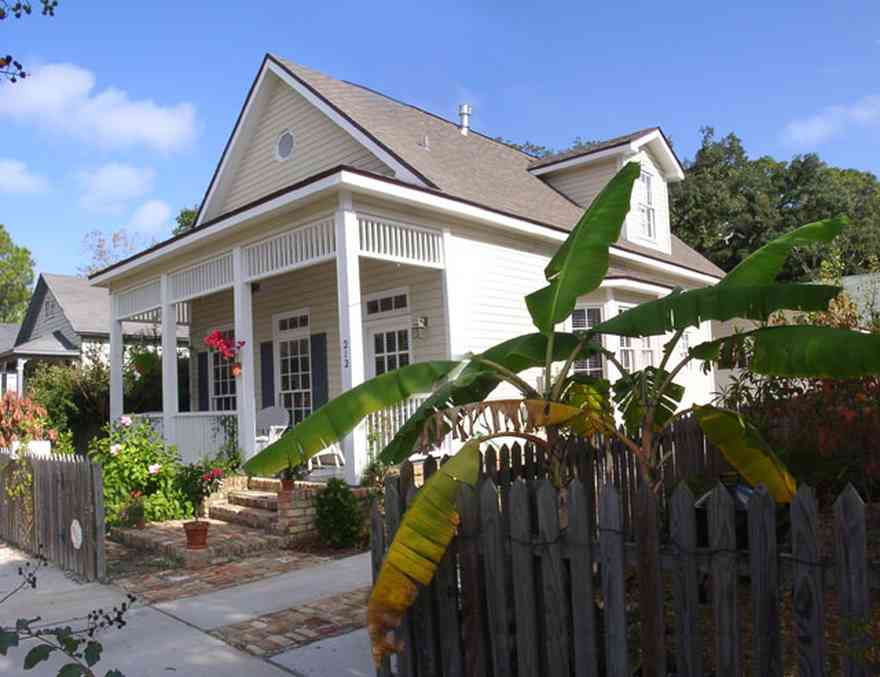
The cottage is located on the east side of Florida Blanca Street.
-

-

Fence trim was designed to match the Gingerbread trim on the house. Orange cosmos plants thrive in the hot sun along the street. A sign on the backyard gate proclaims 'Farmer Dave.' He plans the cottage garden in an informal style with sunflowers. Sometimes the vegetable patch will creep into the front yard with big, green collard plants creating an interesting contrast in the spring.
-

The home is an example of the 'late Cracker' four-square Georgian with classic principles of symmetry, formality and elegance. The building tradition was passed down from the earliest single-pen examples built in the country. The four-square is the town house version of the style.
-

The term four-square refers to a floor plan with a broad central hallway with two rooms to either side. The rooms were large and square in proportion. Two back-to back fireplaces and a common chimney separated each pair of rooms. Porches were part of the social tradition in the days before air conditioning like an outside parlor. Along the streetscape, porches are aligned like one long room.
-

-

-

-

-
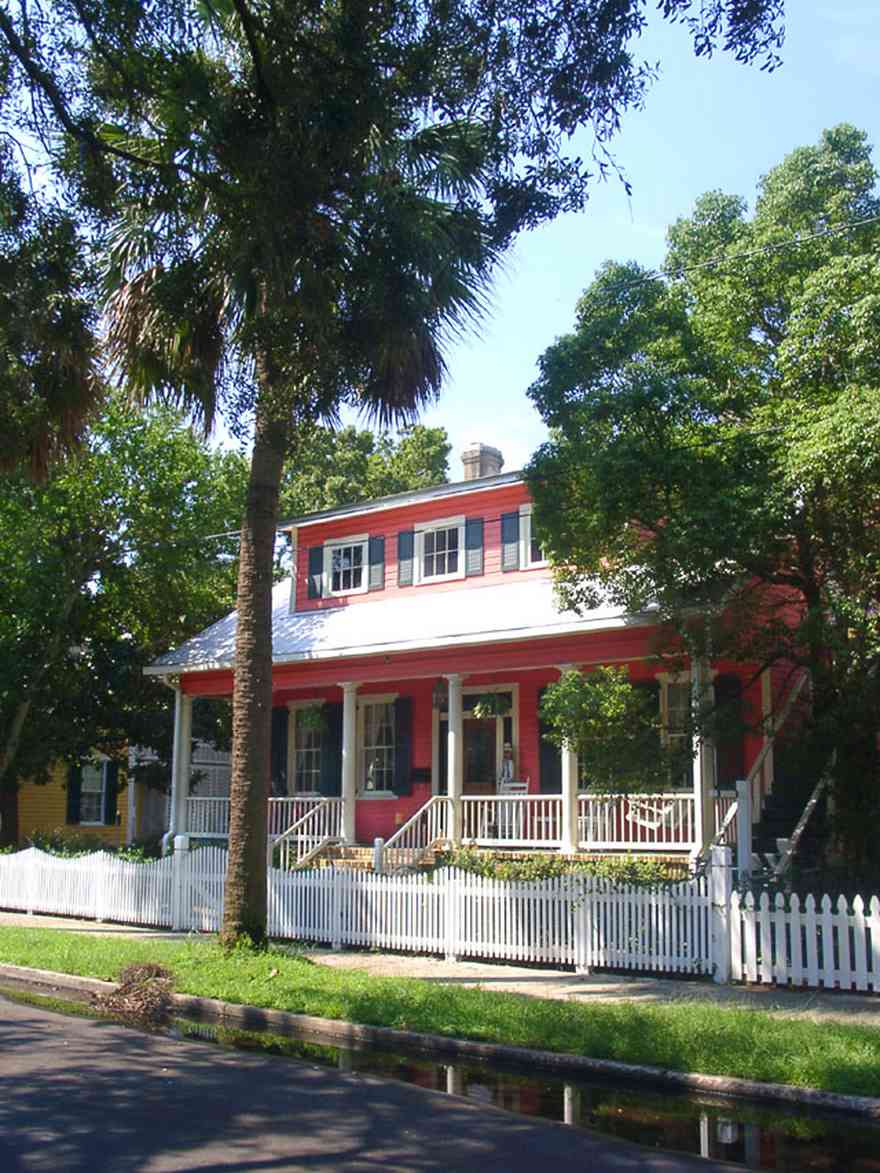
The Victorian cottage is located across the street from Seville Square.
-

The blocks surrounding Seville Square have many other examples of this popular house style of the period.
-

-

-
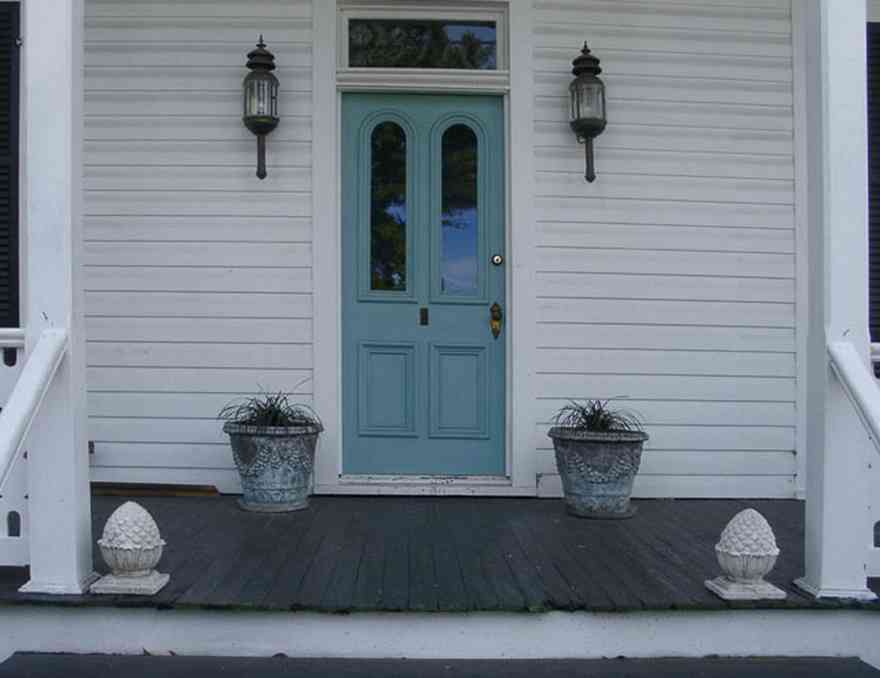
-
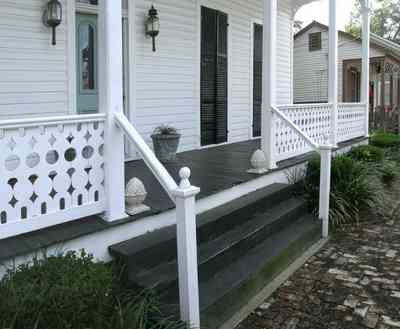
-

-

-

The ceiling of the porch is painted sky blue to "scare" away the haunts or ghosts. The color of the house, shutters and ceiling are traditional and the most popular colors used during the 19th century.
-

The Gulf Coast Cottage is decorated for Christmas with twinkling lights trimming the porch railings and picket fence.
-

The buildings was constructed in 1895 by the St. Michael Creole Benevolent Association.
-
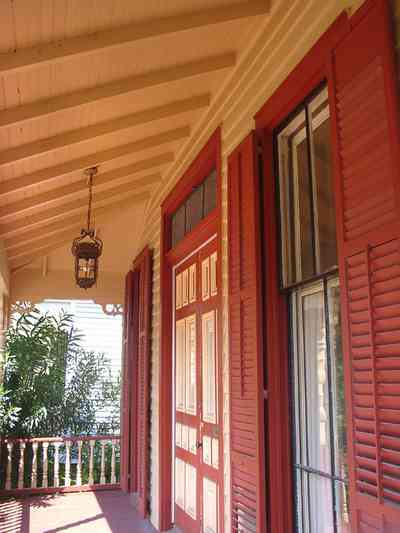
The elaborate color scheme is unusual in the historic district where most of the homes were painted white with green trim and gray.
-

Gail and George Sullivan were presented with a first place award in the Pensacola Historic District Property Owners annual Christmas decorating contest.
-

This Victorian home which dates from 1870's is unique in lavish decorative elements.
-

The home is located on Zaragoza Street. It faces north. The streetscape shows a variety of Victorian cottages dating from the 1870's.
-
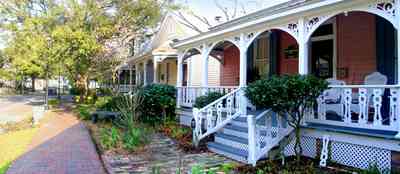
This eastern view of the home shows the brick sidewalks in the Historic District. The infrastructure includes underground utilities and decorative lanterns.
-
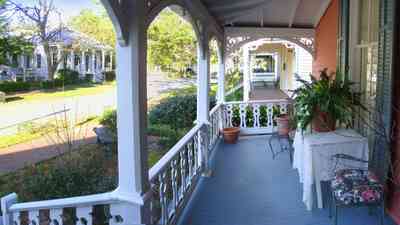
The porch of the home and the neighboring houses reflect a series of outdoor living rooms which function as a public space. This view shows the northeast corner of Florida Blanca and Zaragoza Street.
-

In this view to the west of the Trawick building, the neighboring structure across the street is located to the north. Jamie's Restaurant has a large parking lot on the west side.
-

A complete view of the neighborhood is seen from the front porch from Florida Blanca Street on the right to Cleland Antique Shop on the far left.
-

Wicker furniture compliments the back porch.
-

The house is elaborately decorated for the Chrismas season. Diane Bigler was presented with a first place award in the multi-use category in the 2002 Pensacola Historic District Property Owners Christmas Decorating Contest.
-

The facade of the home shows a typical view of the shotgun style with a side opening door. The floor plan of such narrow houses usually are configured with a living area in the front room. The house is one room wide.
-

The cottage is decorated with natural materials.
-

The view of the downstairs porch shows the rich detail of the Victorian molding.
-

The house is known as the Moreno Anderson House, built between 1859 and 1868.
-

-

-

This is the home of proprietor, Connie Newton.
-

A view from the porch shows the southeast corner of Government and Alcaniz Street. The porches of the Connie Cottage and the Lind house are approximately 20 feet apart.
-

The home is decorated for Halloween.
-

Connie Newton enjoys a quiet moment on the front porch.
-

The realty firm is located on Government Street near Seville Square.
-

The houses share a common porch line which is indicative of a 19th century village.
-

This is the only example of a steamboat facade in the historic district.
-

-

The building is located at the corner of Government and Alcaniz Streets.
-

The old photograph is part of the survey that was used to establish the Pensacola Historic District in the late 1960's.
-

The Suzannah Cottage was built in 1804 and is the oldest structure in the district.
-

The building is located on Government Street.
-

The Minshew firm was presented with a first place in the Pensacola Historic District Property Owners decorating contest.
-
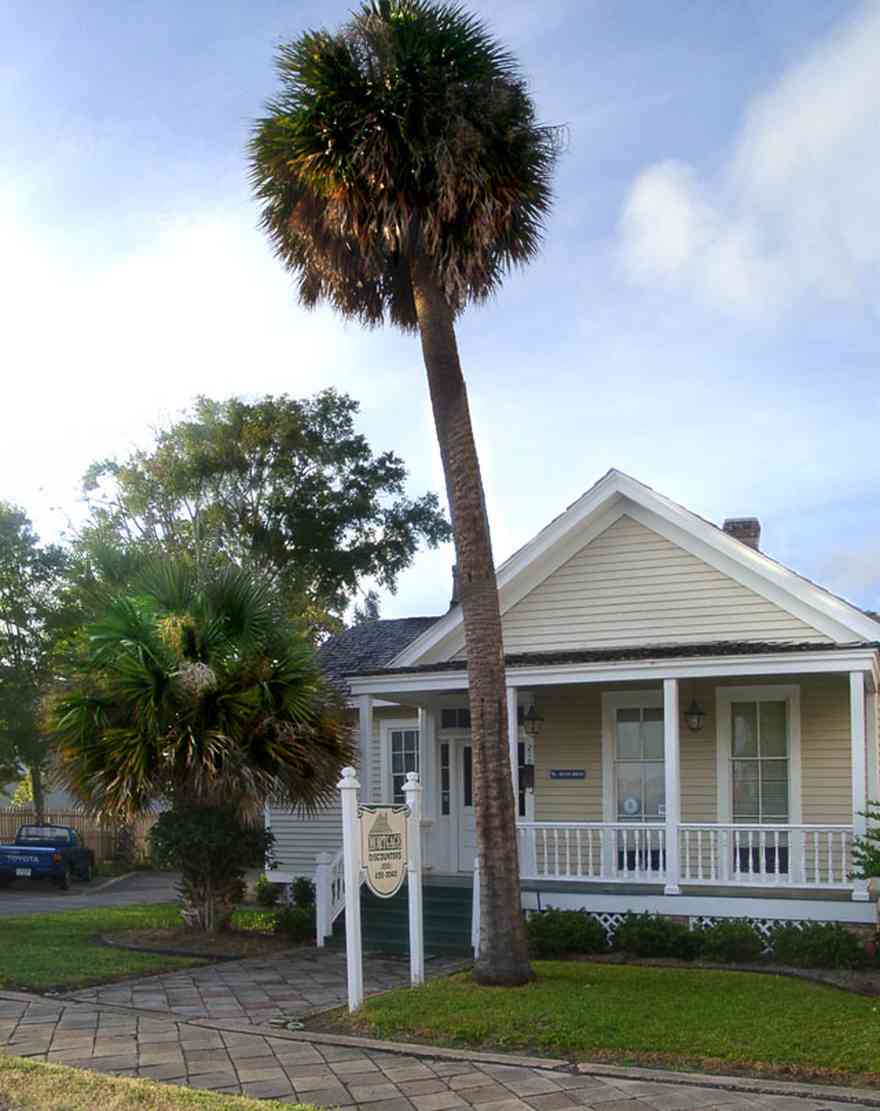
The company is located in the Flynn House on Intendencia Street.
-

This side view of the porch shows the fine detail of this Creole cottage.
-

-

The back porch of the home faces the Gulf of Mexico.
-

This north view shows the facade of the house which faces the Gulf of Mexico
-

-

-

-

-

-

-

-
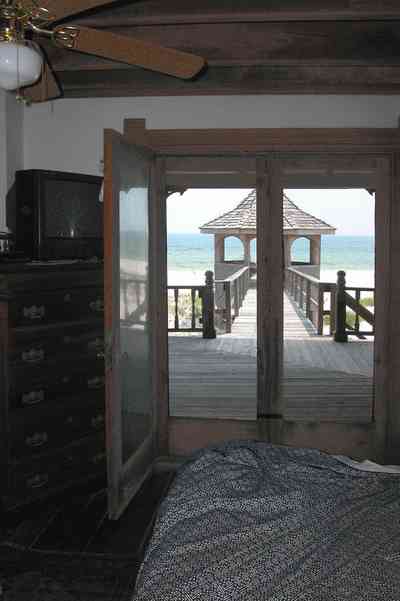
-

second floor porch - west side
-

second floor back porch
-

west view from second floor porch
-
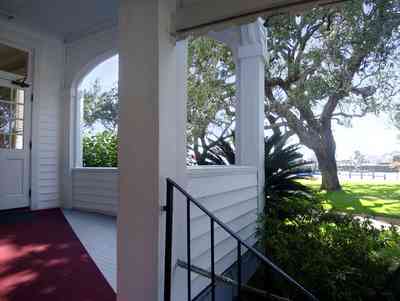
-

-

-

The home is located in the Bohemia development on Scenic Highway.
-
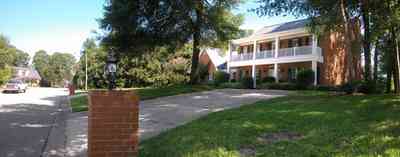
A circular driveway is the central feature of the front yard.
-

There is an overstory of large oak trees throughout the entire development.
-

Residences line the bayshore. Like the example above, each lot has a pier and docking facilities.
-

Shady porches front and back were the major distinction between this single-pen Cracker cabin and a more primitive Seminole Chickee.
-

The corner of the building shows square-hewn log construction with dove-tail notching.
-
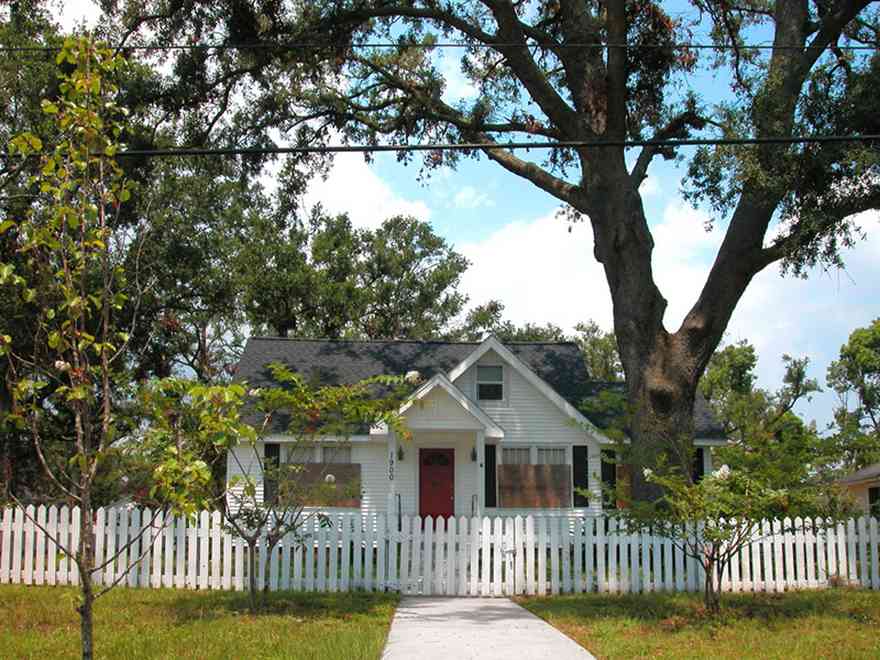
Large oak trees frame the small cottage in one of Pensacola's historic neighborhoods.
-
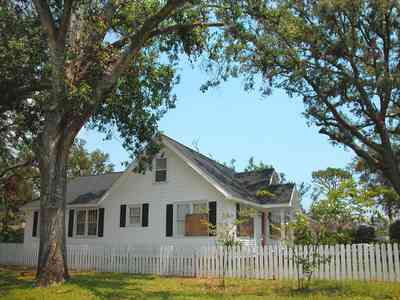
The side of the house shows the depth of the lot and expansive yards in the neighborhood.
-

The porch overlooks Escambia Bay.
-

The home was designed to resemble a Victorian cottage.
-

-
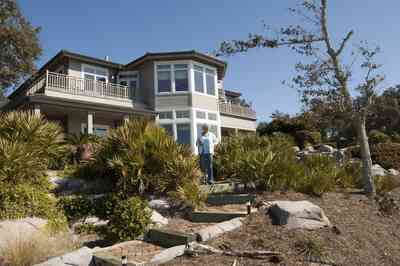
The home overlooks the sound, facing south.
-
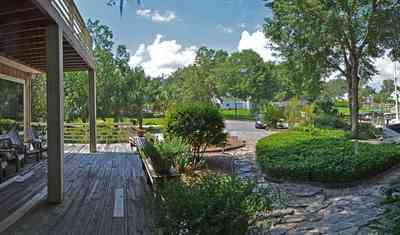
front-facing cul de sac

 The facade of the home shows the narrow lot width with the typical side porch feature.
The facade of the home shows the narrow lot width with the typical side porch feature. Guests for the home tour are greeted by Sophia as the check-in point on the porch of the O'Donovan house.
Guests for the home tour are greeted by Sophia as the check-in point on the porch of the O'Donovan house. The house was designed by local architect, Michelle NacNeal who also planned the Aragon community. The landscaper is Mike Robertson. Ms. Ritchie served as her own interior designer and the home is a reflection of her career in public service.
The house was designed by local architect, Michelle NacNeal who also planned the Aragon community. The landscaper is Mike Robertson. Ms. Ritchie served as her own interior designer and the home is a reflection of her career in public service. In a Charleston Side Yard home, pediments and korbels are important decorative elements. The pediments are the decorative elements on top of the colums. Korbels are the corner fan-like decorations in open lattice work.
In a Charleston Side Yard home, pediments and korbels are important decorative elements. The pediments are the decorative elements on top of the colums. Korbels are the corner fan-like decorations in open lattice work.

 The rear storage building can be seen through the kitchen window.
The rear storage building can be seen through the kitchen window.
 Pensacola Bay can be seen from the second floor balcony.
Pensacola Bay can be seen from the second floor balcony.




 The crew and ad agency representatives watch the actors during one of the first takes of the day.
The crew and ad agency representatives watch the actors during one of the first takes of the day. Porches surround the house on both floors.
Porches surround the house on both floors. This side view of the house shows another interesting turret on the back.
This side view of the house shows another interesting turret on the back. The distinguishing feature of a Neoclassical house is a portico of white classical columns, Ionic, Corinthian or Doric columns, dormer windows, and side porches are elements common to the style of the 1900's to 1940's.
The distinguishing feature of a Neoclassical house is a portico of white classical columns, Ionic, Corinthian or Doric columns, dormer windows, and side porches are elements common to the style of the 1900's to 1940's. This house is built in the classical revival style.
This house is built in the classical revival style. The massive front pediment is flanked by clusters of columns.
The massive front pediment is flanked by clusters of columns. This home is another example of classical revival style. The curved central portico gives the house a soaring grace.
This home is another example of classical revival style. The curved central portico gives the house a soaring grace. The blooming azalea's form a lace trim in the garden.
The blooming azalea's form a lace trim in the garden. This is a typical Cracker homestead. Cracker refers to the unpretentious people and architecture found on farms and in rural communities still sprinkled throughout the Florida peninsula and panhandle wetlands.
This is a typical Cracker homestead. Cracker refers to the unpretentious people and architecture found on farms and in rural communities still sprinkled throughout the Florida peninsula and panhandle wetlands. A separate kitchen structure was built out back to isolate the heat of cooking and the hazards of fire.
A separate kitchen structure was built out back to isolate the heat of cooking and the hazards of fire. Water was pumped by hand. The well was dug at the rear of the house adjacent to the kitchen.
Water was pumped by hand. The well was dug at the rear of the house adjacent to the kitchen. The pump is set just off the back of the main house.
The pump is set just off the back of the main house. With broad porches and this "dog trot" breezeway, the interior space was somewhat insulated for direct sunlight. It also served as a sheltered workspace. The kitchen building is at the end of the walkway.
With broad porches and this "dog trot" breezeway, the interior space was somewhat insulated for direct sunlight. It also served as a sheltered workspace. The kitchen building is at the end of the walkway. Houses were built high up off the damp ground on piers.
Houses were built high up off the damp ground on piers. The outhouse can be seen through the trees. Toilets were small wooden buildings commonly with two seating spaces. Unheated, the privy was cold in the wintertime. Waste built up under the seat until it was necessary to move the privy, or construct a new one. At night, women and girls made use of a flanged bucket known asa a slop jar and kept it under their beds. There is a slop jar on the corner of the porch. Indoor plumbing did not come to most farms until the 1930's, 1940's, or 1950's.
The outhouse can be seen through the trees. Toilets were small wooden buildings commonly with two seating spaces. Unheated, the privy was cold in the wintertime. Waste built up under the seat until it was necessary to move the privy, or construct a new one. At night, women and girls made use of a flanged bucket known asa a slop jar and kept it under their beds. There is a slop jar on the corner of the porch. Indoor plumbing did not come to most farms until the 1930's, 1940's, or 1950's. Cracker homesteaders oriented their houses on a north-south axis which maximized solar impact on all three sunny sides. Such a tactic helped to keep the wall dry. Placement of the fireplace and chimney in the north gable end would keep that fourth sunless wall dry as well. In the photograph, the wood is stacked off the ground alongside of the chimney.
Cracker homesteaders oriented their houses on a north-south axis which maximized solar impact on all three sunny sides. Such a tactic helped to keep the wall dry. Placement of the fireplace and chimney in the north gable end would keep that fourth sunless wall dry as well. In the photograph, the wood is stacked off the ground alongside of the chimney. The home is centrally placed on a hill.
The home is centrally placed on a hill. The house is located in the historic district.
The house is located in the historic district. The side of the home is accessed from Church Street.
The side of the home is accessed from Church Street. The house is surrounded by groves of hardwood trees.
The house is surrounded by groves of hardwood trees. The home is a modern interpretation of the Jacobean style, based on medieval English houses.
The home is a modern interpretation of the Jacobean style, based on medieval English houses. The home is located on a large lot overlooking Bayou Texar. The lot is bisected by Whaley Avenue. A summer kitchen and boat dock are on the water side of the street.
The home is located on a large lot overlooking Bayou Texar. The lot is bisected by Whaley Avenue. A summer kitchen and boat dock are on the water side of the street. The front is divided into three porch types - screen, open and glass enclosure.
The front is divided into three porch types - screen, open and glass enclosure. Tricia Mangrum stands at the front door. The door on the right is for the office.
Tricia Mangrum stands at the front door. The door on the right is for the office. There is a glassed-in room used as an office in the front of the north wing of the house which matches the screen porch on the south wing.
There is a glassed-in room used as an office in the front of the north wing of the house which matches the screen porch on the south wing. The glassed-in front porch is used as an office by Michael Mangrum.
The glassed-in front porch is used as an office by Michael Mangrum. An open seating area is located between the screen porch and the glassed-in office.
An open seating area is located between the screen porch and the glassed-in office. The tree swing is a family favorite.
The tree swing is a family favorite. A screen porch is on the south wing of the home.
A screen porch is on the south wing of the home.
 The screen porch enclosure is on the south side of the house.
The screen porch enclosure is on the south side of the house. The screen porch functions as a dining area.
The screen porch functions as a dining area. Bayou Texar can be seen from the screen porch.
Bayou Texar can be seen from the screen porch. The living room adjoins the open front porch.
The living room adjoins the open front porch.





 The French doors lead to the screen porch.
The French doors lead to the screen porch. The screen porch serves as an outdoor living area.
The screen porch serves as an outdoor living area. The screen porch serves as an outdoor living area.
The screen porch serves as an outdoor living area. The second floor sceen porch and the open porch are auxillary living spaces.
The second floor sceen porch and the open porch are auxillary living spaces.



 The hipped roof is a distinguishing feature of the bungalow style which is particularly appropriate for hot climates, since warm air rises up into the high roof and leaves the rooms below cooler.
The hipped roof is a distinguishing feature of the bungalow style which is particularly appropriate for hot climates, since warm air rises up into the high roof and leaves the rooms below cooler. The original concrete porch flooring was replaced with pine wood by Ron Berthelot.
The original concrete porch flooring was replaced with pine wood by Ron Berthelot. One or one-and-a-half-story Craftsman houses are called bungalows. The Berthelot bungalow exemplifies the style with its wide, deep front porch, supported by thick, simple columns which sit on brick pedestals.
One or one-and-a-half-story Craftsman houses are called bungalows. The Berthelot bungalow exemplifies the style with its wide, deep front porch, supported by thick, simple columns which sit on brick pedestals. The Craftsman (or Arts and Crafts) movement in America developed as a reaction against the machine-made ornamental excess of the Victorian era. This was a back-to-nature movement, reflecting a desire to return to simpler times when craftsmen worked with their hands and took pride in detail. Structural detail and the use of good materials were prized over applied ornamentation. The bungalow has its roots in California, where this style was well suited to the warm climate. It then spread across the country to become one of the most common middle-class designs from 1910 to the 1930's.
The Craftsman (or Arts and Crafts) movement in America developed as a reaction against the machine-made ornamental excess of the Victorian era. This was a back-to-nature movement, reflecting a desire to return to simpler times when craftsmen worked with their hands and took pride in detail. Structural detail and the use of good materials were prized over applied ornamentation. The bungalow has its roots in California, where this style was well suited to the warm climate. It then spread across the country to become one of the most common middle-class designs from 1910 to the 1930's. New glass-front kitchen cabinets were designed for easy access from both kitchen and dining areas. This feature benefits the homeowners every day.
New glass-front kitchen cabinets were designed for easy access from both kitchen and dining areas. This feature benefits the homeowners every day. Visible outside the sunny dining area are deep rafters, which are typical of bungalows, craftsman architecture, and southern seaside cottages, all suggested by this renovated and restored 1928 home. To maximize views, shutters are the only dressing on any windows. These were salvaged from a garage sale. The 1950's turquoise and black dinette was grabbed at a flea market in Pace, Florida, just north of Pensacola.
Visible outside the sunny dining area are deep rafters, which are typical of bungalows, craftsman architecture, and southern seaside cottages, all suggested by this renovated and restored 1928 home. To maximize views, shutters are the only dressing on any windows. These were salvaged from a garage sale. The 1950's turquoise and black dinette was grabbed at a flea market in Pace, Florida, just north of Pensacola. Much of the year, the bungalow spreads out-of-doors. At the Berthelot home, four French doors open into the screened porch, which is comfortably furnished for relaxing, eating, and entertaining. In this Northwest Florida climate, the cooler autumn and gloriously floral spring are especially welcoming, but the shady setting, southern architecture, and a ceiling fam lure folks out even on hot summer days and nights.
Much of the year, the bungalow spreads out-of-doors. At the Berthelot home, four French doors open into the screened porch, which is comfortably furnished for relaxing, eating, and entertaining. In this Northwest Florida climate, the cooler autumn and gloriously floral spring are especially welcoming, but the shady setting, southern architecture, and a ceiling fam lure folks out even on hot summer days and nights. By lowering the pine porch floor and adding a step down, Ron enhanced spaciousness. The original beveled ceiling is echoed in new kitchen cabinets. Open space atop the cabinets is ideal to display serving pieces or fun collectibles, such as an antique Donald Duck, a tin top, and a handmade wooden bus.
By lowering the pine porch floor and adding a step down, Ron enhanced spaciousness. The original beveled ceiling is echoed in new kitchen cabinets. Open space atop the cabinets is ideal to display serving pieces or fun collectibles, such as an antique Donald Duck, a tin top, and a handmade wooden bus. Wire-mesh screen was used on windows and doors in the Victorian era, but it was the Craftsman bungalow style that introduced the screen porch to the American home. Screen porches served to blur the distinction between outside and interior space and allowed the benefits of fresh air to be enjoyed without the annoyance of insects.
Wire-mesh screen was used on windows and doors in the Victorian era, but it was the Craftsman bungalow style that introduced the screen porch to the American home. Screen porches served to blur the distinction between outside and interior space and allowed the benefits of fresh air to be enjoyed without the annoyance of insects. The screen porch provides a large exterior living area on the south and west side of the Berthelot bungalow.
The screen porch provides a large exterior living area on the south and west side of the Berthelot bungalow. The half acre, 150 x 125 foot lot still benefits from the masterful gardening of the Larcom family who owned the home for decades. The Berthelots are particularly indebted to camellia expert Franklin B. Larcom whose legacy blooms faithfully each winter and spring.
The half acre, 150 x 125 foot lot still benefits from the masterful gardening of the Larcom family who owned the home for decades. The Berthelots are particularly indebted to camellia expert Franklin B. Larcom whose legacy blooms faithfully each winter and spring.



 This is a view of the home across the street from the driveway.
This is a view of the home across the street from the driveway.





 The great room has a view overlooking Escambia Bay facing north.
The great room has a view overlooking Escambia Bay facing north. The back porch view shows the shallow width of Dead Man's Island. The bay side of the island has narrow dune formations. Sea grasses and trees are the vegetation on the channel side of the island.
The back porch view shows the shallow width of Dead Man's Island. The bay side of the island has narrow dune formations. Sea grasses and trees are the vegetation on the channel side of the island. A typical small bunkhouse has a screened in backporch.
A typical small bunkhouse has a screened in backporch. The Old Schoolhouse Inn offers luxury accomodations.
The Old Schoolhouse Inn offers luxury accomodations. The rooms at the School House have high ceilings and hardwood floors. Each room has a full bath, microwave, coffeepot and mini refrigerator.
The rooms at the School House have high ceilings and hardwood floors. Each room has a full bath, microwave, coffeepot and mini refrigerator. The cottage has a back porch that overlooks Wolfe Creek.
The cottage has a back porch that overlooks Wolfe Creek. The restaurant is open on weekend evenings for dinner and available for special events.
The restaurant is open on weekend evenings for dinner and available for special events. The restaurant is two blocks from the courthouse.
The restaurant is two blocks from the courthouse. There are two front rooms which serve as dining areas.
There are two front rooms which serve as dining areas. The dining rooms are accessed from a central hall.
The dining rooms are accessed from a central hall. This dining room is on the south side of the central hall.
This dining room is on the south side of the central hall. The dining room is furnished like a hunting lodge.
The dining room is furnished like a hunting lodge. The house is situated on 40 acres of pasture land.
The house is situated on 40 acres of pasture land.


 A series of decks and walkways lead down the hill in the rear of the home.
A series of decks and walkways lead down the hill in the rear of the home.




 A combination of elements, such as the small pediment forms over the windows and front door echo the large pediment over the front porch.
A combination of elements, such as the small pediment forms over the windows and front door echo the large pediment over the front porch. The house is located on the corner of Conecuh and Berryhill Street.
The house is located on the corner of Conecuh and Berryhill Street. The two-story structure is 3,600 square feet with 4 bedrooms and 4 bathrooms, a formal parlor and living room with an additonal family room.
The two-story structure is 3,600 square feet with 4 bedrooms and 4 bathrooms, a formal parlor and living room with an additonal family room. This house has the distinction of having the first indoor tub installed in Milton, Florida. That claw-footed model is still in use.
This house has the distinction of having the first indoor tub installed in Milton, Florida. That claw-footed model is still in use. The house is an example of gothic revival architecture which its central tower, unique silhouette and decorative elements.
The house is an example of gothic revival architecture which its central tower, unique silhouette and decorative elements. This unusual Victorian home was said to have been shipped upriver in several pieces.
This unusual Victorian home was said to have been shipped upriver in several pieces.

 From the second level deck, an northeasterly view reveals a shoreline with white crystal beaches. This area is known for sugar sand dune formations that have been called the whitest beaches in the world.
From the second level deck, an northeasterly view reveals a shoreline with white crystal beaches. This area is known for sugar sand dune formations that have been called the whitest beaches in the world. This view from the second level deck faces southeast on Santa Rosa Sound.
This view from the second level deck faces southeast on Santa Rosa Sound. The owner's dog Ginger, meanders along the dock with the southern facade of the home and beach visible in the background.
The owner's dog Ginger, meanders along the dock with the southern facade of the home and beach visible in the background. The front porch is flanked by guardian lions.
The front porch is flanked by guardian lions. The windows on the first floor extend from floor to ceiling in an arch design using leaded glass panes. The doors are built in double sets.
The windows on the first floor extend from floor to ceiling in an arch design using leaded glass panes. The doors are built in double sets. This is a view from the porch adjacent to the master bedroom overlooking the front yard.
This is a view from the porch adjacent to the master bedroom overlooking the front yard. The upstairs deck of the Florida Room is a convenient porch off the master bedroom.
The upstairs deck of the Florida Room is a convenient porch off the master bedroom. The windows on the east side are sheltered by canvas awnings.
The windows on the east side are sheltered by canvas awnings.









 The door in the breakfast nook opens onto the back garden.
The door in the breakfast nook opens onto the back garden. A small deck connects the screened porch off the family room with the breakfast nook.
A small deck connects the screened porch off the family room with the breakfast nook. The screened porch adjoins the family room.
The screened porch adjoins the family room.


 The small window is decorated with three styles of columns used on the house facade.
The small window is decorated with three styles of columns used on the house facade. The family room opens onto the screened porch.
The family room opens onto the screened porch.
 Full length window open onto the front porch. The facade of the house faces south.
Full length window open onto the front porch. The facade of the house faces south. Floor length windows open onto the front porch in the west front parlor.
Floor length windows open onto the front porch in the west front parlor. There is a front porch set back on the east side of the facade. This is a view from the central hall.
There is a front porch set back on the east side of the facade. This is a view from the central hall. The east parlor has several floor length windows which open onto the front porch.
The east parlor has several floor length windows which open onto the front porch. Two full length windows frame the east corner of the house in the front parlor.
Two full length windows frame the east corner of the house in the front parlor. The design of the home is based on classical or Renaissance precedents.
The design of the home is based on classical or Renaissance precedents. The Greek Revival home on the corner of Brainard and Spring Street was built in 1910.
The Greek Revival home on the corner of Brainard and Spring Street was built in 1910.


 Original materials were procurred to match the new building including cedar shakes from Canada and cypress beams from Louisiana.
Original materials were procurred to match the new building including cedar shakes from Canada and cypress beams from Louisiana. The screen porch was detailed to match the front porch of the main house and brackets were placed to support the exposed rafter tails as on the main house.
The screen porch was detailed to match the front porch of the main house and brackets were placed to support the exposed rafter tails as on the main house.
 This window is on the west side of the front living room.
This window is on the west side of the front living room.






 The Queen Anne house has approximately 5000 square feet of living area on three floors. It is located on the northeast corner of Gonzales and Baylen Streets. The property was much larger when the house was built, but an owner during the 1920's sold the backyard to his son because of his desire to have him live close by.
The Queen Anne house has approximately 5000 square feet of living area on three floors. It is located on the northeast corner of Gonzales and Baylen Streets. The property was much larger when the house was built, but an owner during the 1920's sold the backyard to his son because of his desire to have him live close by. A Florida room was added to the home in 1940 to allow more room for one the quadroplex apartments upstairs. It breaks the Victorian lines of the home but there are no plans to remove the addition.
A Florida room was added to the home in 1940 to allow more room for one the quadroplex apartments upstairs. It breaks the Victorian lines of the home but there are no plans to remove the addition. The stone on the exterior of the house were ballast stones thrown ashore by 19th century sailing vessels that were in Pensacola to take on lumber. Stones are commonly used in large North Hill homes.
The stone on the exterior of the house were ballast stones thrown ashore by 19th century sailing vessels that were in Pensacola to take on lumber. Stones are commonly used in large North Hill homes. A balcony railing was situated as porch roof trim. Plans are underway to restore this important architectural element.
A balcony railing was situated as porch roof trim. Plans are underway to restore this important architectural element. Queen Anne houses are spectacularly crafted.
Queen Anne houses are spectacularly crafted. This is the corner of LaRua and Barcelona Street.
This is the corner of LaRua and Barcelona Street.
 Queen Anne house are characterized by towers or turrets.
Queen Anne house are characterized by towers or turrets.

 Some of the streets in the Old East Hill neighborhood have an uncovered brick base.
Some of the streets in the Old East Hill neighborhood have an uncovered brick base.









 The house was rebuilt in 1995. Stainless steel trim and hardware were added to the exterior finishing.
The house was rebuilt in 1995. Stainless steel trim and hardware were added to the exterior finishing. The second floor deck wraps around the house and is an extension of the interior living space.
The second floor deck wraps around the house and is an extension of the interior living space. The staircase bisects the deck leading to the downstairs living area.
The staircase bisects the deck leading to the downstairs living area. The home is a vernacular farmhouse with one-story porch.
The home is a vernacular farmhouse with one-story porch. The vernacular farmhouse can be seen as an attempt to return to the good old days, with a rocking chair on the front porch.
The vernacular farmhouse can be seen as an attempt to return to the good old days, with a rocking chair on the front porch. The oak trees create a tunnel effect.
The oak trees create a tunnel effect. Vernacular homes are often identified by their structure, rather than ornament.
Vernacular homes are often identified by their structure, rather than ornament. The back of the cottage faces the LaValle House.
The back of the cottage faces the LaValle House. This is a north view of the cottage.
This is a north view of the cottage. From the vantage point of the back porch of the cottage, the Lear House can be seen through the trees. The houses are separated by a picket fence.
From the vantage point of the back porch of the cottage, the Lear House can be seen through the trees. The houses are separated by a picket fence. At the northwest corner of the cottage, the facade of the Tivoli House can be seen.
At the northwest corner of the cottage, the facade of the Tivoli House can be seen. From this side view, the kitchen garden can be seen. It is planted and maintained by Escambia County Master Gardeners. A variety of greens and lettuce are the winter crop.
From this side view, the kitchen garden can be seen. It is planted and maintained by Escambia County Master Gardeners. A variety of greens and lettuce are the winter crop. In this view three houses in the village complex can be seen. The Julee Cottage is directly behind the LaValle House. The Tivoli House is the last building on the right of the photograph.
In this view three houses in the village complex can be seen. The Julee Cottage is directly behind the LaValle House. The Tivoli House is the last building on the right of the photograph. The front porch faces Church Street.
The front porch faces Church Street. The LaValle house museum is a rare example of French Creole colonial architecture. LaValle House was built during Florida’s second Spanish period by Carlos LaValle and Marianna Bonifay. The house is furnished with authentic 18th and 19th century artifacts recreating the frontier lifestyle of Pensacolians.
The LaValle house museum is a rare example of French Creole colonial architecture. LaValle House was built during Florida’s second Spanish period by Carlos LaValle and Marianna Bonifay. The house is furnished with authentic 18th and 19th century artifacts recreating the frontier lifestyle of Pensacolians. The Lear House is a museum in the Historic Village. The interior is furnished in the style of the 1920's.
The Lear House is a museum in the Historic Village. The interior is furnished in the style of the 1920's. The Lear House is a central element to the development of Historic Pensacola Village. Since 1988, a series of grant projects have prepared the structure for its role as a museum house. The house museum theme completes a historical timeline in the Historic Pensacola Village that is launched from the exhibits of the Colonial Archaeological Trail. The time period represented at the Lear House provides a contrast to the Victorian theme displayed at the nearby Dorr House.
The Lear House is a central element to the development of Historic Pensacola Village. Since 1988, a series of grant projects have prepared the structure for its role as a museum house. The house museum theme completes a historical timeline in the Historic Pensacola Village that is launched from the exhibits of the Colonial Archaeological Trail. The time period represented at the Lear House provides a contrast to the Victorian theme displayed at the nearby Dorr House. A view from the west side of the first floor front porch. Zaragoza Street can be seen on the right and the interior yard of the home is on the left. The Lavalle Cottage Museum is in the far left corner of the site. There is a common kitchen garden and courtyard between the buildings.
A view from the west side of the first floor front porch. Zaragoza Street can be seen on the right and the interior yard of the home is on the left. The Lavalle Cottage Museum is in the far left corner of the site. There is a common kitchen garden and courtyard between the buildings. From the front porch facing south, the Weaver's Cottage can be seen to the right. The entrance of the parking lot that services the complex is left of the Weaver's Cottage. Twenty-five vehicles can be parking alongside and behind the cottage.
From the front porch facing south, the Weaver's Cottage can be seen to the right. The entrance of the parking lot that services the complex is left of the Weaver's Cottage. Twenty-five vehicles can be parking alongside and behind the cottage. The gardens around the house are tended by the Escambia County Master Gardeners. A bed of caladiums wrap around the west side of the house.
The gardens around the house are tended by the Escambia County Master Gardeners. A bed of caladiums wrap around the west side of the house. Colonial re-enactors give tours of the house during the yearly open house at the village.
Colonial re-enactors give tours of the house during the yearly open house at the village. The old Episcopal Parish schoolhouse on Church Street can be seen from the northwest corner of the house.
The old Episcopal Parish schoolhouse on Church Street can be seen from the northwest corner of the house. The Marker was placed by Don Tristan de Luna Chapter of the National Society, Daughters of the American Colonists, and Historic Pensacola Preservation Board, 1992. The text of the marker reads as follows: The Lear-Rocheblave House was built on the site of the British Government House of the 1770’s. Built by John and Kate Lear, the house was purchased in 1897 by Benito Rocheblave, a local tug boat captain. The Rocheblave family has long been part of West Florida’s historical tradition, having settled in Colonial Spanish Florida around 1817.
The Marker was placed by Don Tristan de Luna Chapter of the National Society, Daughters of the American Colonists, and Historic Pensacola Preservation Board, 1992. The text of the marker reads as follows: The Lear-Rocheblave House was built on the site of the British Government House of the 1770’s. Built by John and Kate Lear, the house was purchased in 1897 by Benito Rocheblave, a local tug boat captain. The Rocheblave family has long been part of West Florida’s historical tradition, having settled in Colonial Spanish Florida around 1817. The viewer is facing the front doors of the cottage on the porch. A reflection of the Lear House can be seen in the window of the door on the left.
The viewer is facing the front doors of the cottage on the porch. A reflection of the Lear House can be seen in the window of the door on the left. The viewer faces west from the vantage point of the porch. The Julee cottage is center frame and the side garden of the Lear House is on the right.
The viewer faces west from the vantage point of the porch. The Julee cottage is center frame and the side garden of the Lear House is on the right. The cottage is a Gulf Coast architectural style with two front doors. The house was divided into two one-room apartments. The pyramid roof was once a common sight in Pensacola. The style is wind-resistant during hurricanes and tropical storms.
The cottage is a Gulf Coast architectural style with two front doors. The house was divided into two one-room apartments. The pyramid roof was once a common sight in Pensacola. The style is wind-resistant during hurricanes and tropical storms. This view of the cottage is taken from the side yard of the Lear-Rocheblave House across the street.
This view of the cottage is taken from the side yard of the Lear-Rocheblave House across the street. The facade of the house faces Zaragoza Street. The original Tivoli High House was demolished in 1937. It was reconstructed in 1976 from photographs and archaelogical evidence. The first floor of the Tivoli House serves as the Historic Pensacola Village gift shop and ticket office.
The facade of the house faces Zaragoza Street. The original Tivoli High House was demolished in 1937. It was reconstructed in 1976 from photographs and archaelogical evidence. The first floor of the Tivoli House serves as the Historic Pensacola Village gift shop and ticket office. The second floor porch of the Tivoli House forms an arcade over the sidewalk on Zaragoza Street.
The second floor porch of the Tivoli House forms an arcade over the sidewalk on Zaragoza Street. An apron porch with an overhang helps keep the house cool during the hot Gulf Coast summers.
An apron porch with an overhang helps keep the house cool during the hot Gulf Coast summers. Currently, the house has been leased for use as an art gallery, "Expressions".
Currently, the house has been leased for use as an art gallery, "Expressions". The house is situated on the south side of Zaragoza Street between the Moreno and Weaver Cottages.
The house is situated on the south side of Zaragoza Street between the Moreno and Weaver Cottages. The house is a good example of a French Creole Cottage. It is rectanglular design with a central hallway and high ceilings.
The house is a good example of a French Creole Cottage. It is rectanglular design with a central hallway and high ceilings. second floor porch trellis
second floor porch trellis south view from second floor porch
south view from second floor porch second floor porch - south view
second floor porch - south view Ceilings of the front porch were traditionally painted blue. In the South Carolina Low Country, there's a name for the blue of porch ceiling: haint blue. Alphonso Brown, a guide with Gullah Tours in Charleston, S.C., explains that a haint is a spirit or a ghost, and in Charleston, many people also paint the trim on their houses blue to ward off evil spirits.
Ceilings of the front porch were traditionally painted blue. In the South Carolina Low Country, there's a name for the blue of porch ceiling: haint blue. Alphonso Brown, a guide with Gullah Tours in Charleston, S.C., explains that a haint is a spirit or a ghost, and in Charleston, many people also paint the trim on their houses blue to ward off evil spirits.









 The building complex consists of four dwelling units. The two front units are designed for combination office and residential use.
The building complex consists of four dwelling units. The two front units are designed for combination office and residential use.





 The cottage is located on the east side of Florida Blanca Street.
The cottage is located on the east side of Florida Blanca Street.
 Fence trim was designed to match the Gingerbread trim on the house. Orange cosmos plants thrive in the hot sun along the street. A sign on the backyard gate proclaims 'Farmer Dave.' He plans the cottage garden in an informal style with sunflowers. Sometimes the vegetable patch will creep into the front yard with big, green collard plants creating an interesting contrast in the spring.
Fence trim was designed to match the Gingerbread trim on the house. Orange cosmos plants thrive in the hot sun along the street. A sign on the backyard gate proclaims 'Farmer Dave.' He plans the cottage garden in an informal style with sunflowers. Sometimes the vegetable patch will creep into the front yard with big, green collard plants creating an interesting contrast in the spring. The home is an example of the 'late Cracker' four-square Georgian with classic principles of symmetry, formality and elegance. The building tradition was passed down from the earliest single-pen examples built in the country. The four-square is the town house version of the style.
The home is an example of the 'late Cracker' four-square Georgian with classic principles of symmetry, formality and elegance. The building tradition was passed down from the earliest single-pen examples built in the country. The four-square is the town house version of the style. The term four-square refers to a floor plan with a broad central hallway with two rooms to either side. The rooms were large and square in proportion. Two back-to back fireplaces and a common chimney separated each pair of rooms. Porches were part of the social tradition in the days before air conditioning like an outside parlor. Along the streetscape, porches are aligned like one long room.
The term four-square refers to a floor plan with a broad central hallway with two rooms to either side. The rooms were large and square in proportion. Two back-to back fireplaces and a common chimney separated each pair of rooms. Porches were part of the social tradition in the days before air conditioning like an outside parlor. Along the streetscape, porches are aligned like one long room.



 The Victorian cottage is located across the street from Seville Square.
The Victorian cottage is located across the street from Seville Square. The blocks surrounding Seville Square have many other examples of this popular house style of the period.
The blocks surrounding Seville Square have many other examples of this popular house style of the period.





 The ceiling of the porch is painted sky blue to "scare" away the haunts or ghosts. The color of the house, shutters and ceiling are traditional and the most popular colors used during the 19th century.
The ceiling of the porch is painted sky blue to "scare" away the haunts or ghosts. The color of the house, shutters and ceiling are traditional and the most popular colors used during the 19th century. The Gulf Coast Cottage is decorated for Christmas with twinkling lights trimming the porch railings and picket fence.
The Gulf Coast Cottage is decorated for Christmas with twinkling lights trimming the porch railings and picket fence. The buildings was constructed in 1895 by the St. Michael Creole Benevolent Association.
The buildings was constructed in 1895 by the St. Michael Creole Benevolent Association. The elaborate color scheme is unusual in the historic district where most of the homes were painted white with green trim and gray.
The elaborate color scheme is unusual in the historic district where most of the homes were painted white with green trim and gray. Gail and George Sullivan were presented with a first place award in the Pensacola Historic District Property Owners annual Christmas decorating contest.
Gail and George Sullivan were presented with a first place award in the Pensacola Historic District Property Owners annual Christmas decorating contest. This Victorian home which dates from 1870's is unique in lavish decorative elements.
This Victorian home which dates from 1870's is unique in lavish decorative elements. The home is located on Zaragoza Street. It faces north. The streetscape shows a variety of Victorian cottages dating from the 1870's.
The home is located on Zaragoza Street. It faces north. The streetscape shows a variety of Victorian cottages dating from the 1870's. This eastern view of the home shows the brick sidewalks in the Historic District. The infrastructure includes underground utilities and decorative lanterns.
This eastern view of the home shows the brick sidewalks in the Historic District. The infrastructure includes underground utilities and decorative lanterns. The porch of the home and the neighboring houses reflect a series of outdoor living rooms which function as a public space. This view shows the northeast corner of Florida Blanca and Zaragoza Street.
The porch of the home and the neighboring houses reflect a series of outdoor living rooms which function as a public space. This view shows the northeast corner of Florida Blanca and Zaragoza Street. In this view to the west of the Trawick building, the neighboring structure across the street is located to the north. Jamie's Restaurant has a large parking lot on the west side.
In this view to the west of the Trawick building, the neighboring structure across the street is located to the north. Jamie's Restaurant has a large parking lot on the west side. A complete view of the neighborhood is seen from the front porch from Florida Blanca Street on the right to Cleland Antique Shop on the far left.
A complete view of the neighborhood is seen from the front porch from Florida Blanca Street on the right to Cleland Antique Shop on the far left. Wicker furniture compliments the back porch.
Wicker furniture compliments the back porch. The house is elaborately decorated for the Chrismas season. Diane Bigler was presented with a first place award in the multi-use category in the 2002 Pensacola Historic District Property Owners Christmas Decorating Contest.
The house is elaborately decorated for the Chrismas season. Diane Bigler was presented with a first place award in the multi-use category in the 2002 Pensacola Historic District Property Owners Christmas Decorating Contest. The facade of the home shows a typical view of the shotgun style with a side opening door. The floor plan of such narrow houses usually are configured with a living area in the front room. The house is one room wide.
The facade of the home shows a typical view of the shotgun style with a side opening door. The floor plan of such narrow houses usually are configured with a living area in the front room. The house is one room wide. The cottage is decorated with natural materials.
The cottage is decorated with natural materials. The view of the downstairs porch shows the rich detail of the Victorian molding.
The view of the downstairs porch shows the rich detail of the Victorian molding. The house is known as the Moreno Anderson House, built between 1859 and 1868.
The house is known as the Moreno Anderson House, built between 1859 and 1868.

 This is the home of proprietor, Connie Newton.
This is the home of proprietor, Connie Newton. A view from the porch shows the southeast corner of Government and Alcaniz Street. The porches of the Connie Cottage and the Lind house are approximately 20 feet apart.
A view from the porch shows the southeast corner of Government and Alcaniz Street. The porches of the Connie Cottage and the Lind house are approximately 20 feet apart. The home is decorated for Halloween.
The home is decorated for Halloween. Connie Newton enjoys a quiet moment on the front porch.
Connie Newton enjoys a quiet moment on the front porch. The realty firm is located on Government Street near Seville Square.
The realty firm is located on Government Street near Seville Square. The houses share a common porch line which is indicative of a 19th century village.
The houses share a common porch line which is indicative of a 19th century village. This is the only example of a steamboat facade in the historic district.
This is the only example of a steamboat facade in the historic district.
 The building is located at the corner of Government and Alcaniz Streets.
The building is located at the corner of Government and Alcaniz Streets. The old photograph is part of the survey that was used to establish the Pensacola Historic District in the late 1960's.
The old photograph is part of the survey that was used to establish the Pensacola Historic District in the late 1960's. The Suzannah Cottage was built in 1804 and is the oldest structure in the district.
The Suzannah Cottage was built in 1804 and is the oldest structure in the district. The building is located on Government Street.
The building is located on Government Street. The Minshew firm was presented with a first place in the Pensacola Historic District Property Owners decorating contest.
The Minshew firm was presented with a first place in the Pensacola Historic District Property Owners decorating contest. The company is located in the Flynn House on Intendencia Street.
The company is located in the Flynn House on Intendencia Street. This side view of the porch shows the fine detail of this Creole cottage.
This side view of the porch shows the fine detail of this Creole cottage.
 The back porch of the home faces the Gulf of Mexico.
The back porch of the home faces the Gulf of Mexico. This north view shows the facade of the house which faces the Gulf of Mexico
This north view shows the facade of the house which faces the Gulf of Mexico







 second floor porch - west side
second floor porch - west side second floor back porch
second floor back porch west view from second floor porch
west view from second floor porch


 The home is located in the Bohemia development on Scenic Highway.
The home is located in the Bohemia development on Scenic Highway. A circular driveway is the central feature of the front yard.
A circular driveway is the central feature of the front yard. There is an overstory of large oak trees throughout the entire development.
There is an overstory of large oak trees throughout the entire development. Residences line the bayshore. Like the example above, each lot has a pier and docking facilities.
Residences line the bayshore. Like the example above, each lot has a pier and docking facilities. Shady porches front and back were the major distinction between this single-pen Cracker cabin and a more primitive Seminole Chickee.
Shady porches front and back were the major distinction between this single-pen Cracker cabin and a more primitive Seminole Chickee. The corner of the building shows square-hewn log construction with dove-tail notching.
The corner of the building shows square-hewn log construction with dove-tail notching. Large oak trees frame the small cottage in one of Pensacola's historic neighborhoods.
Large oak trees frame the small cottage in one of Pensacola's historic neighborhoods. The side of the house shows the depth of the lot and expansive yards in the neighborhood.
The side of the house shows the depth of the lot and expansive yards in the neighborhood. The porch overlooks Escambia Bay.
The porch overlooks Escambia Bay. The home was designed to resemble a Victorian cottage.
The home was designed to resemble a Victorian cottage.
 The home overlooks the sound, facing south.
The home overlooks the sound, facing south. front-facing cul de sac
front-facing cul de sac One Tank of Gas
One Tank of Gas